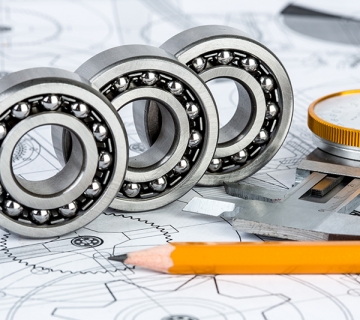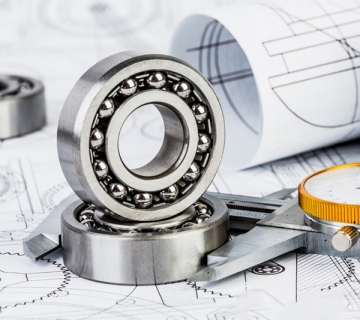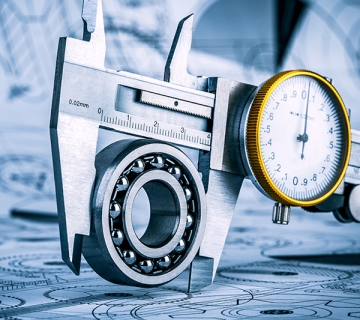Bearing (Bearing) is an important part of contemporary machinery and equipment. Its main function is to support the mechanical rotating body, reduce the friction coefficient during its movement, and ensure its rotation accuracy (accuracy). According to the size and operating speed, rolling bearings have their own unique sound. If the reasons for the following sounds can be distinguished, it will be of great help to judge the bearing damage in advance.
01 Raceway sound
The raceway sound is caused by the rolling elements rolling in the raceway when the bearing rotates to excite a kind of smooth and continuous noise. It only attracts people’s attention when its sound pressure level or tone is extremely large. In fact, the sound energy excited by the raceway sound is limited. Under normal circumstances, the high-quality 6203 bearing raceway sound is 25 ~ 27dB, this kind of noise is most typical of the single row deep groove ball bearing bearing radial load.
The sound source of the raceway is caused by the natural vibration of the inner and outer rings after being loaded. The elastic contact between the inner and outer rings and the rolling elements constitutes a nonlinear vibration system. When the lubrication or machining accuracy is not high, it will excite the natural vibration related to this elastic characteristic, and it will become noise when it is transmitted to the air. As we all know, even if the most advanced manufacturing technology is used to process bearing parts, there will always be small geometric errors of varying degrees on the working surface, so that small fluctuations between the raceway and the rolling elements will excite the natural vibration of the vibration system. Although it is unavoidable, high-precision machining of the working surface of the parts can be used, the correct selection of bearings and the precise use of bearings to reduce noise and vibration.
Features: Noise and vibration are random; · Vibration frequency is above 1kHz; · No matter how the rotation speed changes, the main noise frequency is almost unchanged, while the sound pressure level increases with the increase of the rotation speed; · When the radial clearance increases, The sound pressure level increases sharply; · The greater the rigidity of the bearing seat, the lower the total sound pressure level; even if the speed increases, the total sound pressure level does not increase much; · The higher the lubricant viscosity, the lower the sound pressure level, but for Grease lubrication, its viscosity, soap fiber shape and size can affect the noise value.
02 Falling body rolling sound
This noise generally occurs in large bearings that bear radial loads at low speeds. When the bearing is running under a radial load, it is divided into a load zone and a non-load zone in the bearing. If the bearing has a certain radial clearance, the rolling elements in the non-load zone do not contact the inner raceway, but it may be possible due to centrifugal force. Contact with the outer ring. Therefore, at low speeds, when the centrifugal force is less than the weight of the rolling elements, the rolling elements will fall and collide with the inner raceway or the cage and excite the natural vibration and noise of the bearing.
Features: · Easily generated during grease lubrication, but not easily generated during oil lubrication. It is easier to produce when using low-quality grease; · It often occurs in winter; · It is also easy to produce when only radial load is applied and the radial clearance is large; · It is also produced in a certain range, and the speed of bearings of different sizes The range is also different; · It may be continuous or intermittent; · The forced vibration often excites the second-order and third-order bending natural vibration of the outer ring, thereby emitting the noise. The preload method can effectively reduce the noise and reduce the radial clearance of the bearing after installation. The selection of good lubricants can also be improved. Some foreign companies use light rolling elements, such as ceramic rollers or hollow rollers. Prevent the generation of this noise.
03 Screaming
It comes from the rather violent squeal sound generated by the sliding friction between metals. Although the bearing temperature is not high at this time, it has little effect on bearing life and grease life, and does not affect rotation, but the sound is sharp and disturbing. Large short cylindrical roller bearings bearing radial loads often have this noise. This noise can be prevented by reducing the radial clearance of the bearing and adopting a shallow outer ring raceway structure.
Features: · Bearing radial clearance is easy to produce; · It usually occurs in grease lubrication, but oil lubrication is rare; · It decreases with the increase of bearing size and often occurs in a certain speed range; · Often in winter Appearance; · Its appearance is irregular and unpredictable, and is related to the amount and performance of grease filling, and installation and operating conditions.
04 Cage sound
In the process of bearing rotation, the free vibration of the cage and its collision with rolling elements or ferrules will cause this noise. It may appear in all kinds of bearings, but its sound pressure level is not too high and low frequency.
Since the cage pocket gap and cage and ring gap are inevitable in the finished bearing, it is very difficult to completely eliminate the cage noise, but it can be improved by reducing the assembly error and optimizing the reasonable clearance and cage movement.
Another kind of special noise of the cage is the noise caused by the self-excited vibration of the cage caused by the friction between the cage and the guide surface of other bearing parts. The stamped cage of deep groove ball bearings is thin, has low bending stiffness in the radial and axial planes, and has poor overall stability. When the bearing rotates at a high speed, it will produce self-excited vibration due to bending deformation, causing “buzzing” .
When the bearing is under radial load and the grease performance is poor, the noise of “click, click” will be heard at the beginning of operation. This is mainly due to the sudden acceleration of the rolling elements and the phase of the cage after the rolling elements leave the load zone. The impact noise is inevitable, but it will disappear after a period of operation.
Features: · Stamping cages and plastic cages can be produced; · Either thin oil or grease lubrication will occur; · Easiest to occur when the outer ring is subjected to bending moment; · Prone to occur when the radial clearance is large.
Measures to prevent cage noise
· In order to stabilize the revolution movement of the cage, the ring guide method should be adopted as much as possible and the guide surface should be fully lubricated. The structure of the tapered roller bearing under high-speed working conditions should be improved, and the roller-guided L-shaped cage should be changed to Z-shaped cage guided by ring ribs;
· When the bearing rotates at high speed, the vibration amplitude of the cage of a bearing with a large pocket gap is much larger than that of a cage with a small pocket gap, so the value of the pocket gap is particularly important;
· Minimize the radial clearance;
· Try to improve the manufacturing accuracy of the cage, improve the surface quality of the cage, and reduce the noise caused by the collision or friction between the rolling elements and the cage;
· Actively adopt advanced cleaning technology to effectively and thoroughly clean the spare parts and the products after the assembly to improve the cleanliness of the bearing.
05 Noise caused by vibration of rolling elements
When the bearing runs under the action of radial load, only a few rolling elements within it bear the load. The “spring” support formed by the elastic contact with the ring makes the rolling elements vibrate periodically through the line of radial load. Therefore, the center of the rotating shaft will move up and down vertically or horizontally, and noise will be induced. This kind of vibration is called rolling element passing vibration, which is more obvious when running at low speed.
The amplitude is related to the bearing type, radial load, radial clearance and the number of rolling elements. Usually the amplitude is small, and the hazard is formed when the amplitude is large. For this reason, often reduce the radial clearance or apply an appropriate preload to reduce.
Types of bearing noise





